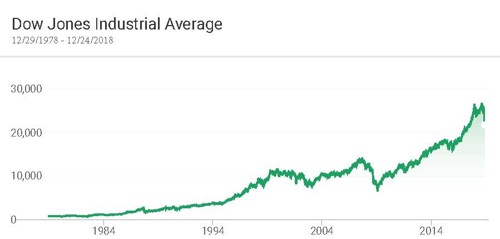Happy New Year 2019!
Happy New Year 2019!
January 3, 2019 by Lesjak Planning
As the year 2018 comes to a close, we reflect back on the past forty years that we have witnessed first hand in this investment business. What stands out most vividly in memory were the major declines. Most of us that experienced the “crashes” in 1987, 1990, 2002, and 2008 would agree that in each decline there was the feeling of dread for what each new day would bring. Coinciding with each crash was either political turmoil, global tensions, or some type of financial industry corruption. In more than one instance, it was all three. “Financial analysts” on television grabbed the limelight with prognostications of markets going to zero as markets imploded and the world falling into the abyss. Quite scary times to be an investor.
Experiencing our first major correction in 1987, admittedly we felt the same fear and uncertainty about what was happening and why. As market values rebounded to new highs and new crashes occurred and also rebounded to new record highs, we became less anxious as to how the volatility would play out although the “how” and “why” of sudden market declines continue to be evasive.
On December 29,1978 the Dow Jones Industrial Average closed at the value of 805. Today the average is near 22,000. That is an increase of 27 times or an average of nearly 10% annually. Of course, most have not been investors for forty years. Shorter time periods show similar results: 30 years was 10.08%, 20 years 10.04%, 10 years 9.9%.

The world and our daily lives have changed considerably over the past forty years but the fact is that the returns experienced investing in equities has remained fairly constant over time.
We have noticed that these past couple of months have experienced very high levels of selling with little buying interest. End of the year tax selling accelerated into December as many mutual funds announced large capital gains distributions. Massive selling also came in as hedge fund managers opened their annual 6-week window on November 15 allowing investors to withdraw their investments. Many took advantage of the window since the best guess is that 150 of these struggling hedge funds will liquidate and close their doors at the end of December. As prices fall due to these large liquidations, computer trading algorithms compound the pressure by generating automatic across the board selling instructions on a large scale. With no buyers willing to step in, prices drop day after day.
Surviving volatility requires remembering your long-term goals and keeping your focus on things others overlook. Fear is backward looking. Stocks are forward looking. Everything investors fear today is old news, rehashed every hour of every day in the media. Big corporation earnings are growing. Third quarter profits for the 500 S&P companies jumped 26% over last year. Revenues rose 9% over the same period a year ago. Seventy seven percent of reporting firms beat prior expectations. These are fundamentals of a growing economy.
Political squabbling is raging as ugly as ever and will most likely lead to gridlock for the next few years. Markets adore gridlock. When politicians fight amongst themselves, they aren’t passing any radical legislation that could roil markets.
Bullish sentiment among individual investors has tanked to the lowest levels in over a year. The fear and greed index readings are about as fearful as they ever get. These drops in sentiment have set the stage in the past for above average returns going forward.
Over the past forty years we have witnessed outstanding growth in the stock markets while holding on during the few short-term corrections experienced along the way. Focusing on the many positives that will affect investments in the future we feel confident that history will repeat itself.
All of us at Lesjak Planning wish you and your family a Happy, Healthy and Prosperous New Year!
The Lesjak Planning Team
Dave, Mike, Marc, Nathan, Kevin, Kathy, and Jessica
Market moves to the upside have historically lasted multiple years in duration
Increases in value come as professional traders and novices alike bid up the share price of a company as its sales and profits increase. Companies with new innovations, excellent marketing and sales can expect investors to want to participate in their success. During times of economic growth and low unemployment, consumers feel good and spend more on goods and services. This spending increases corporate profits which drives stock prices higher and overall market values with them. These are the good times in which fear of loss is low.
Sharp market declines are a lot less orderly. Most are caused by an unexpected incident which catches traders off-guard which then results in the sell now-research later reaction. Past incidents include corporate accounting fraud, mortgage lending and banking fraud, investment firm collapses, computer trading miscues and various others. Uncertainty is the enemy of the markets.
Returning to the present, the sharp decline since the most recent market highs in October resembles those in the past with extreme selling caused by the fear of the unknown outcome of multiple issues facing our political structure, world order, and future economic growth.
A look at supply and demand in the stock market suggests that the current decline has more in common with a correction than a full-fledged bear market. Since this most recent bull market began in 2009 there have been three sizeable corrections. The decline in 2010 was 16%, 2011 was 19.4%, and 2015 was 14.2%. The current market decline since September is 17.5% which is in line with the past three. On average, it took markets 4.5 months to get back to new highs after each of those corrections. If previous declines are any guide, we can be looking for the end of this one to be coming soon.












































About the author
Lesjak Planning